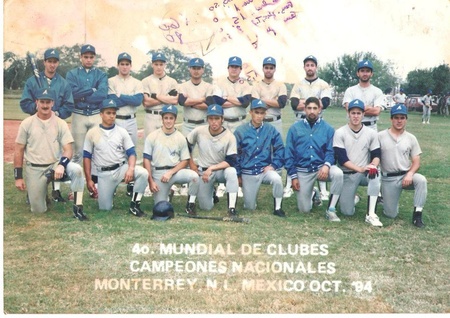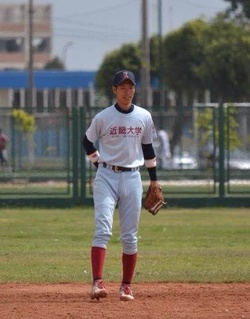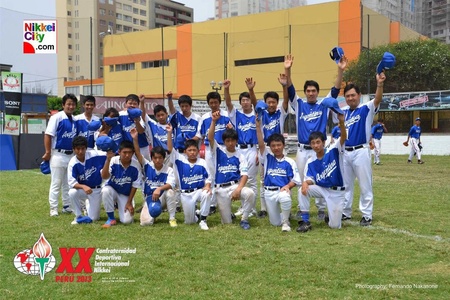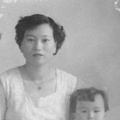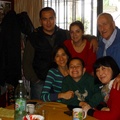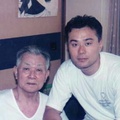In Colonia Urquiza, the students of the Japanese school practice various physical activities as part of the curriculum and recreation, which leads them, in some cases, to watch sports professionally, as occurs with ping pong and baseball. Soccer and volleyball attract teenagers, while golf, park golf and sport fishing attract adults.
Baseball began to gain momentum in the '90s, managing to form Nikkei children's delegations in Argentina, to compete with their peers in Japan. It is worth mentioning that in Argentina this sport was gaining ground, managing to form the Metropolitan League of the Province of Buenos Aires, where there are teams made up only of Japanese descendants and other mixed teams, which compete in children's, pre-junior, junior and adult tournaments, with the provincial leagues at the national and international level.
Baseball in Argentina. The Nikkei (interviews)
In 1888 and together with the formation of the Buenos Aires Baseball Club, made up mostly of North American residents 1 , Baseball began to be played in Argentina. Mr. Jorge Newbery, uncle of the famous aviator and athlete, was one of its main promoters. As the years went by, new teams were formed. In 1925 the Argentine Association was founded. In the period between 1925 and 1930, the Standard Oil Co., Piratas BC, Youth Christian Association, and GEBA teams were part of the first division. In 1932, the Association was transformed and changed its name to the Argentine Baseball and Softball League. Its heyday crystallized in the Buenos Aires area starting in 1950, with the entry of Venezuela BC, which would star in a golden campaign.
The Argentine Baseball and Softball Federation began activities at the national level in 1957, organizing the First Argentine Baseball Championship for seniors. Argentina grew gradually, falling behind Brazil, Venezuela and Ecuador, the continent's greatest exponents. Argentina received a visit from important foreign teams: in 1965, Den Den from Japan, Kanebo from Brazil in 1968 and Toshiba Co. from Japan in 1978. In 1973, the senior team participated in the first Intercontinental Cup in Italy. The final location marked the last square, but the important thing was the global insertion. Our country also organized the First World Youth Championship of the International Association in 1977.
At the Pan American Games in Mar del Plata (1995), the national team gave the big surprise by beating the United States and Puerto Rico, thus gaining qualification for the final round, where it placed fifth. In 2004, the national team won the South American championship absolutely for the first time, beating Brazil in the final.
The history of baseball among the Nikkei is related to the creation of the Seibu Club in 1952, which began with baseball practices on the Rugby field of the Matreros de Morón Club. They participate in the Nippar Tournament for teams from the Japanese community. From 1953 to 1960 they practiced the sport on the Farrel Family lands, which they later acquired. In 1956 it joined the Metropolitan Baseball League and in the 1956-1957 season it was classified as runner-up, the following year second division champion. Division and in 1959-1960 champion of 1st Division 2 . Over time, the Japanese associations in the province of Buenos Aires began to organize themselves in the practice of baseball, setting up fields and participating in intercollegiate tournaments, forming teams for the Metropolitan League 3 .
In Colonia Urquiza, the year after the creation of the club, in 1964, the Baseball department began its activities. The head of that department was Irinoda Susumu, who formed a team of young people who began training at the Nitta family field on weekends. They participated in tournaments organized by Nippar in which they won the first title. But in the mid-70s, the team dissolved. In the 1980s, Mr. Nakajima and Mr. Bunno Kazuyosh proposed rebuilding the team with a very small group. Juan Nishizawa managed to participate in a tournament organized in Japan, invited by the Japanese Federation, which motivated many boys to be part of the team.
In 1987, Morita Sachi began his activity, for a few years as a coach with children from 6 to 12 years old. In 1994, after demanding training, they began to participate in the Metropolitan Baseball League, winning the title in all categories except intermediate and then the objective would be to compete against other teams in Japan. 4 Several of the former players are currently managers or coaches of the La Plata Japanese Association teams, such as: José Saito, Fernando Miyawaki and Ángel Miyawaki, who in their career managed to stand out and be part of the teams that traveled to Japan , also from the Metropolitan League and the National Team, like Rodolfo Murayama. 5
Fukutoshi Takabayashi, (Baseball Coaching) 6 commented that in Japan he coached high school baseball teams for more than 30 years and in 2009 he obtained a master's degree in Sports Psychology at Seitoku University in Tokyo: “I Essential for the baseball player to achieve the greatest performance and efficiency in his game is the need to know the fundamentals of baseball and to be able to practice it in training. The fundamentals include physical preparation, catching and throwing technique, batting, basic concept of each position, training form, tactics, signs, etc. Another important aspect to take into account in this sport is the communication that must exist between the players and the coach, and also the constant attention to the game to be able to anticipate plays and give the appropriate response both in defense and attack.” 7
“I managed to fulfill my dream in Argentina, where I was welcomed as a senior JICA volunteer. “I was called to form a team that participated in international tournaments as a representative of Argentine baseball.” “My motto: Practices are for winning. He reiterated over and over again that no one practices to lose; That is why one must train with all the desire. I blindly believed in it. However, in Argentina baseball had another focus: more than winning or losing, the most important thing was to enjoy. That fact impacted me, as did the support of the players' families. Thinking about it, if you don't enjoy it, maybe it's not worth playing baseball. I felt like that was the starting point. Instead of giving, I received a lesson. Now I think about how to make sure that one can enjoy the practices and the games.” “The curious thing is that in Argentina things are done that were lost in today's Japan. “I feel the strong bond of cooperation and friendship that unites the team, which arises around Argentine baseball.” 8
Rolando Petit, scout for the Atlanta Braves, visited Salta and Buenos Aires in search of new talents to join his organization and said: “Argentina is a new frontier for baseball.” Thanks to the efforts of the local talent detector, Amaro Costa, he arrived at the La Plata diamond. After practice, Petit left enthusiastic about the work of some of the players, although he later stated that "the boys lack game", maintaining that they must practice almost every day and have many confrontations. 9 In another report 10 to members of the baseball team, we can glimpse how the sport is growing, the winners of the 2003 season of the official baseball tournament. Víctor Aramayo and Tomás and Benjamín Trombetta are three of the members of a team that has a great future and despite how difficult it is to practice an amateur sport, they are the faithful representatives of a community that does what it likes and feels. "This sport was instilled by the Japanese community. Unlike other clubs, we have everything necessary to play baseball. Of course everything comes from the help of parents who organize festivals to raise the necessary funds," explained Víctor Aramayo pitcher or third basis of the team.”
“My name is Hidenori Tachizuka 12 , I am part of the Volunteer Program for the Nikkei Society, I was appointed to work at the Baseball Club of the Japanese Association of La Plata. My mission is to be the baseball coach of this association in all its categories. The objective is not only limited to improving Baseball techniques but, through this sport, teaching young people to socialize and work as a team, instilling responsibility and discipline. I am also scheduled to coach the Nichia Gakuin and Japanese Escobar Association baseball clubs. I am aware that not all the techniques of Japanese Baseball can be accommodated in Argentina.”
Rodolfo Murayama: in his career he has managed to stand out in the local team from a very young age, he was called up for the National Team, receiving in 1996, one of the annual awards given by the Argentine Nikkei Center, since 1986, where it distinguishes the young people under forty years of age, with the title “Outstanding Young Nikkei”. His performance in sport was highly praised in the newspaper La Prensa de Nicaragua, on November 27, 2000, where it was mentioned that in the match between Argentina and Nicaragua for the pre-world tournament, the performance of Rodolfo Murayama stood out. . 13 He is currently the coach of the children's category in Colonia Urquiza, which is preparing to compete in 2015 with its peers in Japan. 14
Within the youth leagues, there are two outstanding players, currently coaches or managers of children's and junior teams in Colonia Urquiza. Fernando Miyawaki was a great player in the 1984 category, according to Toshiki Nakashima, and that the team he was part of in 2004 won all the categories of the Metropolitan League, gaining access to first A. Ángel Miyawaki, currently stands out as a player in the Metropolitan League, category A for adults. Among the juniors, Facundo Yamaguchi, year after year, receives awards for his performance on the playing field. “I started at the age of 6, in the children's category, where I participated in the Pontevedra tournament in 2011, winning the ferro final. We also participated in a Nikkei sports fraternity tournament, in 2 national tournaments, one in Buenos Aires and the other in Salta. I was called to the Argentine national team for the Pan-American baseball tournament that was held in Guatemala.” “In 2012 we played a tournament in Peru. 15 We participated in the 2012 friendship tournament, where I won the award for best pitcher of the tournament. In another national tournament that was held in Salta, I received the trophy for the best pitcher. With the Argentine Baseball Team we traveled to Honduras. In that Pan American, we were the surprise, beating the host and Costa Rica. In 2013, we participated in the Nikkei tournament that was held in Peru, where I won the award for best 3rd baseman.”
About the player Mitsuhiro Fukunaga, according to the words of a coach, Toshiki Nakashima, Mitsuhiro began to stand out since 2002, and due to his sporting ability, he went through all the categories, he was part of the metropolitan team and was hired to play in Centro America, he was there for several years. He then joined an amateur league in Japan, where he remained for a year. He returned to Argentina to help in the family job of parker. He died in 2013 and as a tribute, the current team wears a logo on its shirt, the number 15, on the left forearm and the tournament is named after him Mitsu Fukunaga. The Japanese Community of Colonia Urquiza has demonstrated over the years the importance of physical activity, not only for children, but also for adolescents and adults, and this is strengthened in a space conducive to practice, since This colony is located in a rural world. The children, trained for local and intercollegiate activities, manage to excel in the competitions of the rest of the Nikkei schools. From those children came the baseball players who later formed part of the national team.
Grades:
1. Baseball, also called baseball or baseball, is a team sport played between two teams of 9 players each. It is considered one of the most popular sports in the United States, Japan, Canada, South Korea, Taiwan, Cuba, Australia, Mexico, Nicaragua, Panama, Puerto Rico, South Africa, Holland, Dominican Republic, Italy, Colombia and Venezuela. The countries considered powers of this sport are concentrated in America (North, Central, Caribbean) and Asia.
2. On May 13, 2000, at an Extraordinary General Assembly, the change of name from Seibu Club to “Japanese Seibu Association” was ratified.
3. http://www.beisbolmetro.com.ar/ Metropolitan League. Currently affiliated with the League are: Vélez, Ferro, Comu, Nichia, Júpiter, Daom, La Plata, Diablos Rojos, Lanús, Las Águilas, Ciudad Jardín, Shankees, Cardenales, Dokdo, Almendares, Tiburones.
4. El Imparcial del Oeste in September 2010, No. 44, page. 10, announces about the training of little Nikkei baseball players, who are preparing for the trip to Japan for an international children's meeting.
5. 50th Anniversary Book of the Japanese La Plata Association, Yakyubu chapter, page. 23 to 25, year 2013.
6. La Plata Hochi of Thursday, October 29, 2009, page. 4. La Plata Hochi, Thursday, October 13, 2011, No. 8389, year 64, page. 1. Millennium No. 119, year 9, November 2011, page. 9.
7. The fundamentals of Baseball. Editor Fukutoshi Takabayashi. Translation: Humberto Koike. Collaborators: Rodolfo Murayama, Takashi Oshiro, Diego Kenji. Coaches: Sergio Kiyan (Nicha), Martín Lucero (Júpiter), Michael Figi (Las Águilas). Made by JICA and LMB.
8. http://www.jica.org.ar/sitio-nuevo-syswarp/images/pdf/2010-1.pdf .
9. Note from Matías Ochoa, about the coach's visit to La Plata, to the sports field of the La Plata Japanese Association (AJLP), in Colonia Urquiza. http://24con.infonews.com/conurbano/nota/41962-Argentina-es-una-nueva-frontera-para-el-b%C3%A9isbol/
10. El Día.com, March 24, 2004.
11. In the Milenio newspaper of August 2011, No. 116, year 9, page. 9. There is a notice stating that on July 9 the parents of the children on the baseball team organized the “Gengis Khan Party” to raise funds for the matches in Paraguay and Peru. For a few years now, it has been stipulated that the dinner is organized in July, in order to raise funds to be used for trips, purchasing uniforms, etc.
12. The report was translated from Japanese to Spanish by: Akiko Tsuru and Takuma Oue.
13. La Prensa, the digital newspaper of Nicaraguans, Tuesday, November 27, 2000, edition No. 22205. More information http://mensual.prensa.com/mensual/contenido/2000/12/02/hoy/especial/deportes/ pan27.shtml .
14. In 2011 the world tournament was suspended due to the tsunami, and Argentina from 2012 to 2014 could not complete the necessary number of players to send to the tournament, so only the category that entered in 2014 meets the requirements to count with 16 players to appear in the championship.
15. La Plata Hochi, March 1, 2012, No. 8421, year 65, page. 1. Note on the Peruvian-Argentine fraternity tournament, where the performance of a representative of the Nikkei Children's Baseball Association of Argentina (ANIBA) stands out.
© 2014 Irene Isabel Cafiero


